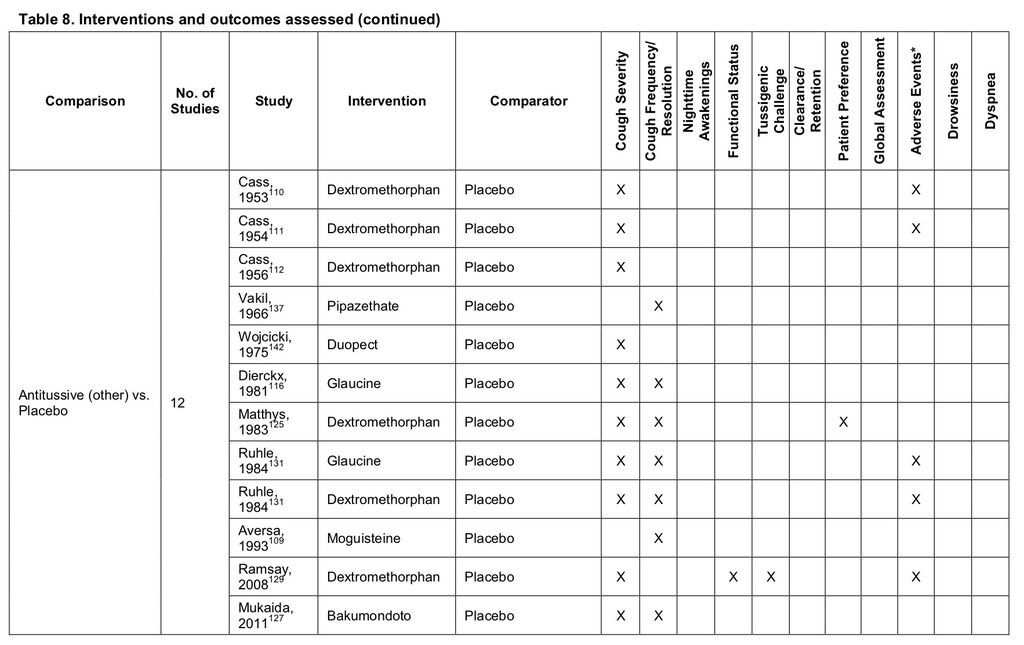
[EXCERPTS]
This comparative effectiveness review (CER) was funded by the Agency for Healthcare Research and Quality (AHRQ) and is designed to evaluate the comparative effectiveness of measurement tools for assessing cough and of symptomatic treatments for chronic cough.
Instruments Used To Assess Cough
Key points from the Results chapter are:
- Electronic recording devices are accurate for assessing cough frequency, but they show variable correlation with instruments that measure other dimensions of cough.
- The Leicester Cough Questionnaire (LCQ) and the Cough-specific Quality of Life Questionnaire (CQLQ) are the most widely studied cough-specific quality-of-life questionnaires in adult populations. Both have demonstrated validity and reliability, with emerging evidence available on responsiveness.
- There is moderate strength of evidence to support the validity and responsiveness of the Parent Cough-specific Quality of Life Questionnaire (PC-QOL) in assessing the severity/QOL of cough among children.
- Emerging data support the responsiveness of recording devices, cough-related questionnaires, and tussigenic challenge tests, but further research is needed to accurately estimate the minimally important difference (MID) of these assessment instruments.
- Although diaries and visual analog scales are based on face validity, assess a wide variety of different cough outcomes, and are widely used both in research and practice, there is little data to validate their accuracy in assessing cough, and what data exist show inconsistent correlations with other cough measurement tools. These tools are usually simple and easy to use, but more data are needed to determine their reliability and validity in assessing cough frequency or severity/QOL.
- While all of the included studies evaluated aspects of the comparative diagnostic accuracy of the various cough measurement tools, none evaluated the comparative therapeutic efficacy or patient outcome efficacy of these tools.
Key Question 2. Nonspecific Therapies for Chronic Cough
Key points from the Results chapter of the full report are:
- A wide variety of pharmaceutical agents have been used to treat the symptom of chronic cough, including opioid, anesthetic, and nonopioid/nonanesthetic antitussives; expectorant and mucolytic protussives; antihistamines; antibiotics; inhaled corticosteroids; and inhaled anticholinergics.
- Patients with unexplained or refractory chronic cough are not well defined as a population in the evidence base, restricting the applicability of many studies.
- Of the agents reviewed, the opioid and certain nonopioid/nonanesthetic antitussives most frequently demonstrated efficacy for managing the symptom of chronic cough in adults.
- There were several important quality limitations in the literature, including (1) too few good-quality studies focusing on chronic cough; (2) relatively short durations of followup (3) a diversity of outcomes measured across studies, which limited between-study comparisons; and (4) when similar outcomes were assessed across studies, the instruments used were diverse and inconsistent, making comparison and interpretation difficult.
- Data on nonpharmacological therapies for chronic cough were sparse.

Conclusions
There is no established gold standard for assessing either frequency or severity/QOL of cough, thereby making it difficult to quantitatively assess test accuracy for cough instruments. Validity of severity/QOL questionnaires was generally demonstrated in the published literature by correlation with other cough assessment instruments, whereas validity of cough recording devices was generally demonstrated using human cough counts as the reference standard. Reliability of questionnaires was generally demonstrated by test-retest correlation and by demonstrating internal consistency. Several instruments, including the LCQ, CQLQ, and the PC-QOL, show good internal consistency but variable correlation with other cough measurement tools. This suggests that these tools may be reliable but demonstrate variable validity. The lack of validated reference tests and the diverse number of instruments used among treatment evaluations also complicates comparisons across studies. We identified no evidence exploring the impact of cough assessment instruments on therapeutic efficacy or patient outcome efficacy.
A wide variety of pharmaceutical agents have been used to treat the symptom of chronic cough, including opioid, anesthetic, and nonopioid/nonanesthetic antitussives; expectorant and mucolytic protussives; antihistamines; antibiotics; inhaled corticosteroids; and inhaled anticholinergics. There were relatively few good-quality studies focusing on chronic cough using reliable outcome measurements over durations of followup pertinent to chronic cough. The opioid and certain nonopioid/nonanesthetic antitussives most frequently demonstrated efficacy for managing the symptom of chronic cough compared with placebo, but there were insufficient data to draw conclusions between therapies. Data on nonpharmacological therapies for chronic cough are extremely limited, as are data on the management of unidentified or refractory chronic cough in children.
Our systematic review highlights the clear need for further studies in patient populations with unexplained or refractory chronic cough as determined by current diagnostic and empiric treatment recommendations. Further, it shows the need for more systematic design and reporting of these studies and assessment of patient-centered outcomes.
[Executive Summary | Free full-text AHRQ Comparative Effectiveness review article PDF]













 留言列表
留言列表
 線上藥物查詢
線上藥物查詢 